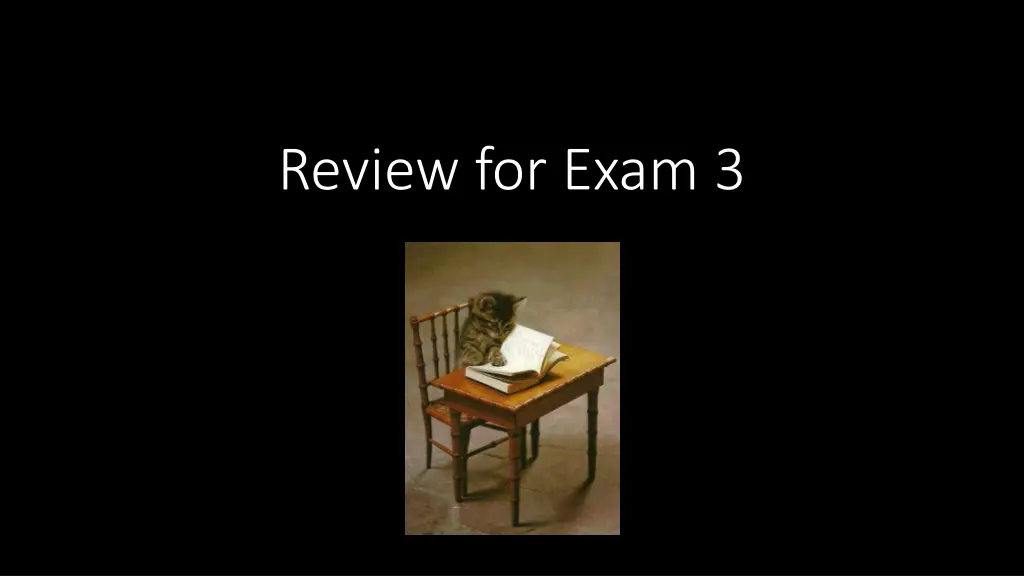
Tips for Effective Exam Preparation
Prepare for your upcoming Exam 3 efficiently with helpful study materials, study tips, test strategies, and in-class activities. Learn what material to focus on, study techniques, and ways to improve your exam performance. Get ready for success in your exam!
Download Presentation

Please find below an Image/Link to download the presentation.
The content on the website is provided AS IS for your information and personal use only. It may not be sold, licensed, or shared on other websites without obtaining consent from the author. If you encounter any issues during the download, it is possible that the publisher has removed the file from their server.
You are allowed to download the files provided on this website for personal or commercial use, subject to the condition that they are used lawfully. All files are the property of their respective owners.
The content on the website is provided AS IS for your information and personal use only. It may not be sold, licensed, or shared on other websites without obtaining consent from the author.
E N D
Presentation Transcript
Exam 3 50 questions 1 hour and 20 minutes to complete exam Multiple choice Lecture slides and notes
What material to study? Follow the study points posted on UBLearns Lecture Material Textbook chapters if you have any question on the lecture material Your own notes
Study Tips Go through the study points and lecture slides Read the chapters actively if you do not fully understand the lecture slides or notes Find a study buddy Use flash cards Email me if you still have questions
Test strategies Usually 1 or 2 answers that are totally incorrect, and then 1 that might sound like it is correct but is not. Studying thoroughly allows you to distinguish between the answer that looks correct and the answer that is correct. Because of the above TAKE YOUR TIME! Don t rush through it, because you may get tripped up by those answers that look correct but are not. ALWAYS put an answer. 25% chance you will get it right by guessing.
In-class activity Imagine you are the professor, post a multiple choice question. This trains you to anticipate the types of questions, so you can focus on what to study Gets you into that type of thinking
The Eukarya Eukaryotes Ediacaran fauna
Faint Young Sun Paradox The trend of solar luminosity Reason the Sun has become brighter The meaning of faint young sun paradox Solution of faint young sun paradox The control of global temperatures via the silicate weathering
Recent and ancient glacial climate indictors Tills Striations Dropstones Tillites
Long-term glacial record Major glaciations Reason for the 1st Huronian glaciation 2.4 billion years ago 2nd Snowball Earth glaciation 700 million years ago Survival of photosynthetic life during the Snowball Earth glaciation Reason for the 4th glaciation Climate and oxygen isotopes Cause and evidence for the 5th glaciation during Cenozoic Era (the last 50 million years)
Pleistocene glaciations (Cenozoic Era) Glaciers in the Antarctic during the Cenozoic Era Glaciers in Greenland during the Cenozoic Era
Glacial cycles Glacial-interglacial cycles during the 2.6 million years of the Pleistocene Glaciation Timing of the most severe glacial events The place where oxygen isotope matches the insolation variations
The role of ocean in the glacial cycles Rates of warming and cooling during glacial cycles Temperatures in interglacial and glacial events atmospheric concentration of carbon dioxide (CO2) and methane (CH4) over the last few glacial cycles Productivity of ocean plankton Dansgaard-Oeschger cycles A 1300 year-long Younger Dryas period began 12900 years ago
The Holocene interglacial Patterns of the northern hemisphere summer insolation, atmospheric concentration of carbon dioxide, and peak temperature in Holocene Inputs to GCMs to explore changes in climatic conditions over the last 18,000 years (which includes the Holocene) African Sahara 9000 years ago Lake levels across the western USA 12000 years ago Extinctions of megafauna in North and South America
Recent warming Glaciers in the Little Ice Age Annual resolution records of temperature Developing a statistical relationship between the instrumental records and the indirect records Global average rate of warming The method of calculating global average from instrumental records Satellite records of global temperature Reason of no trend in global average mean temperature during 1945-1975 Reason of slowdown in atmospheric warming since 2000 CE El Ni o (associated with southern Pacific Ocean) and its cause
Course evaluation Time 21 Apr 2023 7 May 2023 If 80% of class fill them in, all of you get extra credit.
